Nuggets of News Blog
|  |
Wednesday, January 21 2015
 If you've not yet attended a GPAA (Gold Prospectors Association of America) Gold & Treasure Show, the coming months provide an opportunity to rub elbows with some of the best prospectors and manufacturers in the business! Browse the show floor to find the latest and greatest gold mining and metal detecting equipment, see product demos, attend free seminars, ask questions of the pros, and enter to win door prizes. Weekend shows run 10 am - 4 pm. Presale admission is $5 by registering online or $10 at the door. If you've not yet attended a GPAA (Gold Prospectors Association of America) Gold & Treasure Show, the coming months provide an opportunity to rub elbows with some of the best prospectors and manufacturers in the business! Browse the show floor to find the latest and greatest gold mining and metal detecting equipment, see product demos, attend free seminars, ask questions of the pros, and enter to win door prizes. Weekend shows run 10 am - 4 pm. Presale admission is $5 by registering online or $10 at the door.
Mark your calendars for these dates and cities:
- February 7-8 Pomona Fairplex in Pomona CA
- February 28-March 1 Mesa Convention Center in Mesa, AZ
- March 7-8 San Joaquin Fair in Stockton, CA
- March 28-29 Portland Expo Center in Portland, OR
- April 11-12 Western Idaho Fair in Boise, ID
- April 25-26 South Point Casino in Las Vegas, NV
- May 16-17 National Western Complex in Denver, CO
- May 30-31 Metrolina Tradeshow Expo in Charlotte, NC
- June 6-7 Knoxville Convention Center in Knoxville, TN
Visit the GPAA website for more details and online registration. See you there!
Monday, January 19 2015
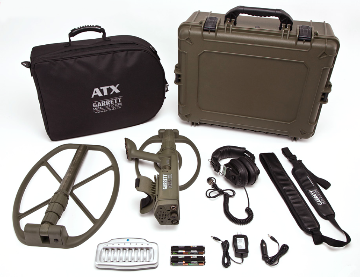 Garrett's new pulse induction ATX metal detector is the ultimate multi-frequency detector for all terrains and extreme conditions (highly mineralized ground, saltwater, etc.). It features advanced pulse induction technology, a durable design that meets military specifications, and an advanced 20 inch Deepseeker searchcoil is ideal for use in searching for caches and other deeply buried large objects. The ATX is waterproof to 10 feet. Garrett's new pulse induction ATX metal detector is the ultimate multi-frequency detector for all terrains and extreme conditions (highly mineralized ground, saltwater, etc.). It features advanced pulse induction technology, a durable design that meets military specifications, and an advanced 20 inch Deepseeker searchcoil is ideal for use in searching for caches and other deeply buried large objects. The ATX is waterproof to 10 feet.
PI (pulse induction) detectors work a bit differently than the more common VLF (very low frequency) detectors by putting magnetic field energy into the ground and then switching off and waiting a short period before they start to look for a response. This makes them better at handling ground mineralization than a VLF detector because during that short delay the magnetic response of iron trash minerals that you don't want to find dies out. VLF detectors do not as easily cancel out ground mineralization the way a PI metal detector can do.
Kevin Hoagland, Executive Director of Development for the Gold Prospectors Association of America recently field tested the Garrett ATX Deepseeker. Below is an excerpt of Kevin's review:
"My first impression of the ATX was that it's compact, heavy and built like a tank, and all connections are waterproof. Battery installation is simple. The ATX uses 8 AA batteries in two 4-battery drop-in packs and comes with an 8-slot AA battery charger. Not only does this detector come with a rugged case and carry bag, but also everything else you need to get out detecting. The units ships with the 20 inch mono coil already installed. It is also shipped with headphones that are screwed into the back of the unit.
I slipped my arm into the adjustable cuff, and grabbed the control pod. There was no unnecessary torque on  my wrist, which gave it a perfect fit and feel, and allowed me to work all of the control buttons easily with my thumb. I pushed the unit out in front of me a bit and turned on the power switch, which is located on the back of the unit. The Garrett ATX Deepseeker Metal Detector goes through its startup and self-diagnostic test. Every light on the control pad comes on and unit emits several different sounds before settling into a comfortable, but high, threshold. This is not a turn-on-and-go detector. Either read the entire owners manual before you go out hunting, or at least read the first two pages of the manual— page 1 is the Quick Start Guide and an explanation of how to access the functions of the ATX quickly, and page 2 shows you where to find more information concerning those functions. my wrist, which gave it a perfect fit and feel, and allowed me to work all of the control buttons easily with my thumb. I pushed the unit out in front of me a bit and turned on the power switch, which is located on the back of the unit. The Garrett ATX Deepseeker Metal Detector goes through its startup and self-diagnostic test. Every light on the control pad comes on and unit emits several different sounds before settling into a comfortable, but high, threshold. This is not a turn-on-and-go detector. Either read the entire owners manual before you go out hunting, or at least read the first two pages of the manual— page 1 is the Quick Start Guide and an explanation of how to access the functions of the ATX quickly, and page 2 shows you where to find more information concerning those functions.
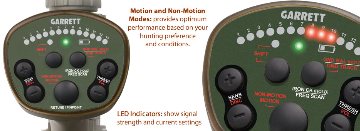 There are 5 major functions that are completely user-adjustable: Mode, Sensitivity, Threshold, Volume, and Ground Balance. Are functions are easy to adjust with a basic understanding of the ATX and more tunable as you become more proficient. Secondary functions include iron check, tracking, discrimmination and frequency shifting, to name only a few. There are 5 major functions that are completely user-adjustable: Mode, Sensitivity, Threshold, Volume, and Ground Balance. Are functions are easy to adjust with a basic understanding of the ATX and more tunable as you become more proficient. Secondary functions include iron check, tracking, discrimmination and frequency shifting, to name only a few.
As with most large PI detectors, the Garrett ATX Deepseeker Metal Detector is not light, and the waterproofing adds extra weight. Were it not for the ergonomic design, detectorists not accustomed to the weight of these machines might tire quickly. The supplied sling is easy to use, adjust, and offers a fair way to alleviate some of the weight, but I found it uncomfortable for long periods of use. Many avid detectorists use after-market harness systems, so you may want to check out those options if you plan to spend long days detecting.
In the field, the Deepseeker performed exceptionally well. The unit demonstrated almost complete immunity to all but the worst hot rocks I encountered. The ground balance and multi-speed ground tracking worked great, but I found that I rarely used the ground tracking as the ATX handled most of the soil mineralization in the OFF position. The threshold was quick to respond to ground changes and a simple ground balance was all that was needed to bring the ATX back into maximum depth and sensitivity. The Iron Check works well, maybe even too well! I dig everything no matter what and I have had a very successful nugget-hunting career doing just that. I have found good targets under junk on many occasions. Be careful and mindful that gold, like junk, is where you find it and there is no law of detecting that states there will be no gold under junk!
Regardless of your level of detecting expertise, it will take some time to get comfortable with all the functions and navigating the menus of the ATX. With multi-button presses to access some functions, it's important to take time to learn the machine well beyond the quick-start level. Overall, Garrett has created a PI detector that is extremely well made with solid functionality. The ATX offers great value for your dollar. Garrett has again carved a niche in the metal detector market, and the ATX perfectly has met the needs expressed by detectorists worldwide..."
You can find Kevin's complete field test review on pages 16-19 of the November/December 2014 issue of Gold Prospectors Magazine, or download the .pdf here. You can also get more information and watch a video of the Garrett ATX Deepseeker Metal Detector on this website.
Sunday, January 11 2015
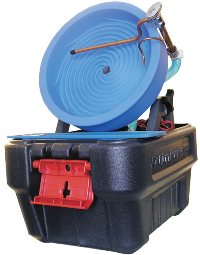 If you're looking for a proven fine gold recovery tool that has been on the market for decades, consider the Desert Fox Spiral Gold Panning Machine. It's easy to use, and recently Kevin Hoagland, Executive Director of Development for the Gold Prospectors Association of America (GPAA) conducted a field test review which was published on pages 14-17 of the January/February 2015 issue of Gold Prospectors Magazine. Here's an excerpt of Kevin's findings and you can also click on the image at the end of this post to download a complete copy of the field test review (4-page .pdf). If you're looking for a proven fine gold recovery tool that has been on the market for decades, consider the Desert Fox Spiral Gold Panning Machine. It's easy to use, and recently Kevin Hoagland, Executive Director of Development for the Gold Prospectors Association of America (GPAA) conducted a field test review which was published on pages 14-17 of the January/February 2015 issue of Gold Prospectors Magazine. Here's an excerpt of Kevin's findings and you can also click on the image at the end of this post to download a complete copy of the field test review (4-page .pdf).
"... The Desert Fox ships in an Action Packer case that is the storage, transport, and water container unit. It provides excellent protection for the Fox while giving you a true compact recirculating unit that can be transported easily. Unpacking the container was simple and for those of us that spend little time looking at the way something comes out of a container, the manufacturer has included a photo in the manual to show you how to repack the unit so it's back to being travel-ready in just a few seconds. In the container you will find:
- A-frame with variable speed drive motor connected as one unit
- 7 lead 12.5 inch double wall spiral recovery wheel
- Adjustable water spray bar
- Tailings catch tray
- 12-volt 750 GPH pump and flow hose from pump to spray bar
- Instructions
- Recovery cup
- Nylon stocking for the pump
- Small bag of practice sand with flecks of real gold.
Setup takes just a few moments. The wheel frame is a single point A-frame that sits perfectly in place in the container and allows you a stable, easy-to-set-up base for the spiral unit. The A-frame construction also allows the unit to be set up directly in a stream. Stand the A-frame in the container, lift the drive unit to a beginning angle, slide the double-wall wheel into the slot on the drive motor, attach the spray bar, fill with water, hook up to a 12-volt power supply (not included), and after a couple of fine tuning adjustments, the Desert Fox is ready to start running your concentrates. Total time from cased to running is about two minutes!
The A-frame mounted drive motor allows you to easily make small adjustments to the angle of the wheel. This ease-of-use factor can become critical when running materials that require more precision. Water flow is controlled by a single-point knob on the spray bar assembly, and the speed control is located on the back of the unit. These 3 adjustments are all you need to ensure efficient gold recovery. Before first use, be sure to clean with a good quality dish washing soap to remove all the manufacturing oils (mold-release agents from the plastic parts). Do NOT use a citrus-scented soap because the scent is derived from oils, which is exactly what you are trying to remove. Use hot soapy water and a non-abrasive pad.
Spiral panners work in reverse of traditional hand panning. Instead of gravity separating gold from concentrates with the heavies sinking to the bottom of a pan, a spiral machine uses speed, water, and the angle of the spiral wheel to keep lighter material in the bottom of the wheel, while the heavier black sand and gold is brought up the leads. When set correctly, the sands drop off at the last moment and only gold is moved through the center of the unit and recovered in the cup.
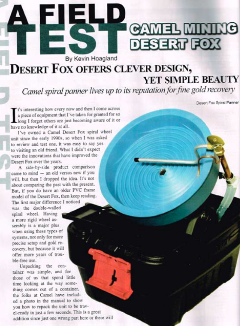 I recommend classifying your dirt to a minimum of .25 inch to 1/8 inch mesh. Once classified and prepared to run, feed the material slowly into the bottom of the wheel. I've found it best to use a tablespoon. Increase the feed rate after all necessary adjustments are made. I recommend classifying your dirt to a minimum of .25 inch to 1/8 inch mesh. Once classified and prepared to run, feed the material slowly into the bottom of the wheel. I've found it best to use a tablespoon. Increase the feed rate after all necessary adjustments are made.
Starting with the water first, find the lowest water pressure that will clean the light material from the leads as it climbs up the pan, adjust the angle and speed as needed so the heavy sands drop off at the right spot and you're ready to start processing your concentrates. After completing the basic setup, I adjusted the speed to keep the unit tuned in to variations in the types of material I ran. There are two models of the Desert Fox— a constant speed ($339) and a variable speed ($359). Since the difference in price is just $20, I highly recommend the variable speed model.
The Desert Fox is a straight-forward and simple spiral wheel system that recovers gold efficiently, and has been manufactured by Camel Mining since 1969. It is compact, weighs about 10 pounds, and is ideal for carrying into the field. Gold recovery is exceptional and the learning curve is short..."
Click here to learn more about the Desert Fox Spiral Panner on this website. Click image to download .pdf of field test review.
Friday, January 02 2015
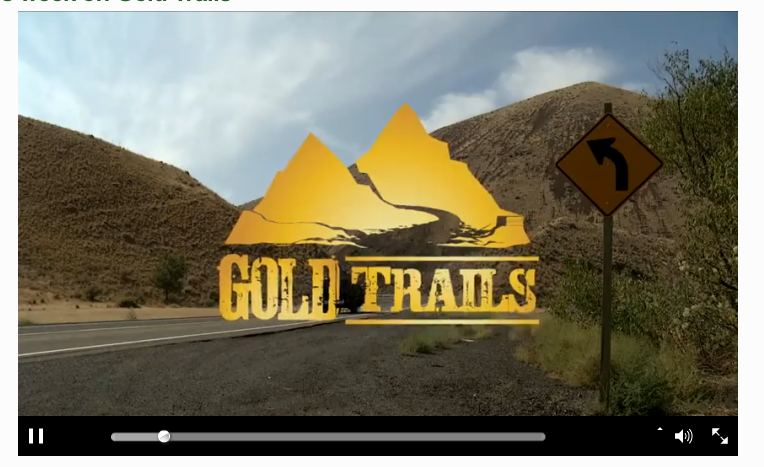 Gold Trails is a new TV show produced by the Gold Prospectors Association of America (GPAA) that promotes the lifestyle of the prospector. Host Kevin Hoagland travels the country working with local prospectors and equipment manufacturers in search of the next big gold strike. Gold Trails is really an introduction for the general public to basic prospecting — to a lot of people who haven’t experienced it yet. Gold Trails is a new TV show produced by the Gold Prospectors Association of America (GPAA) that promotes the lifestyle of the prospector. Host Kevin Hoagland travels the country working with local prospectors and equipment manufacturers in search of the next big gold strike. Gold Trails is really an introduction for the general public to basic prospecting — to a lot of people who haven’t experienced it yet.
The premiere episode of Gold Trails will air Saturday, January 3, 2015 on the following local TV stations:
- KDOC TV — Los Angeles, 8 a.m (LA 56 — Verizon Fios HD is 506)
- AZTV — Phoenix, Ariz. — 11 a.m.
- KWVT — Salem, Ore., 10:30 a.m. (available to viewers in Portland)
The following excerpt and information is found on the GPAA's website.
Gold Trails has been three years in the making, but is worth every minute of the wait, said GPAA President and Executive Producer Brandon Johnson. He’s confident viewers will feel the same by the time they’ve watched all seven weekly half-hour episodes of this first season. Though Johnson, who is Tom Massie’s stepson, is carrying on the family business, he has stepped outside of the Massie family for the first time with the choice of Hoagland as the on-camera personality and the public persona of the GPAA. But, Hoagland is first and foremost a gold prospector with solid roots in the small-scale mining industry as well as the GPAA and Lost Dutchman's Mining Association, so he’s a natural fit.
Although Johnson is a gold prospector and miner, he admits he never grew up immersed neck-deep in mining the same way as Tom and Perry Massie did. Still, he has spent countless hours at mining camps with Tom, his mother, Cindy and his siblings and he’s grown to love the mining community and GPAA family. “My grandfather was a miner. What drives me is not necessarily the mining as much as that mining community my grandfather created,” he said.“It was always important to me. To me it’s a great pleasure.”
It takes a certain kind of person to be on-camera and, Johnson by his very nature ducks and dodges the limelight, preferring instead a behind-the-scenes management approach. “I wouldn’t be opposed to it, if it makes sense for the episode,” he said, quipping, “I can give a tour of the office.” Humbly, he said, that the miners who are out in the field, rolling up their sleeves and getting down to the nitty-gritty can better reflect what gold prospecting is all about to viewers than he can as a company president, which carries with it the burden of financial and managerial responsibilities. “They have so much more to say than I do ... but I have no problem jumping in there,” he said.
Johnson is convinced Hoagland is the right person for the job of Gold Trails host. “This is a show that we’ve been passionate about producing for a few years, but the chemistry really needed to be right. My grandfather was a baseball player, and so he built a baseball field. We’ve had the opportunity with the baseball field for a long time, but we’ve been looking for the right players and the right coach. Now, I think we’ve got that,” Johnson said. “To me, it’s important. I can probably play baseball, but I’m not a baseball player; Kevin is. So, with his ability and how similar our passion is — as far as his passion to get the information out there and to help people and the joy he gets from it — I’ve got a baseball player. I can continue to be the athletic director, while Kevin is taking on the responsibility from a television, media standpoint ... and I’m a big supporter of it.”
While Gold Trails started out much like Gold Fever episodes (another GPAA TV series), the formula was changed to make it more educational with a little less of the antics that are Tom Massie’s trademark.
Although Hoagland had been visible in the mining industry, Johnson was especially impressed with him at a GPAA Gold & Treasure Show, where Hoagland had led a popular seminar on metal detecting. It was apparent then — and still is — that Hoagland’s passion for prospecting floweth over the proverbial cup. And, he has the knowledge and experience to back it up.
Listening to the story of how Hoagland got his first metal detector and then set out to create a better one, and then explore metals and geology, Johnson was impressed with Hoagland’s inquisitive nature, gumption and gusto. “I think that says a lot about how Kevin’s mind works ... He wanted to understand how the Earth works. He is very knowledgeable,” Johnson said. “We had a similar focus. I’ve met hundreds of people over the years at gold shows, but Kevin really stood out — his voice and his presence and his knowledge of prospecting.”
Rather than having six minutes of commercial time for big national advertiser on Outdoor Channel, Johnson hopes Gold Trails will expand from three to 20 different local markets, which means plenty of advertising spots for local mining equipment and prospecting shops. “Gold Trails to me is about starting that gold rush everyone expected to happen. I think a lot of people have a fascination with gold when the price fluctuates. People get excited about prospecting for gold, but I don’t think many of them know how to get started, ” Johnson said. “We’re giving people the next step. The prospecting and mining industry, really doesn’t have a show like this.”
And, no other gold prospecting TV series can offer viewers a chance to join a national membership-based organization and go out prospect on mining claims across the United States. The GPAA also has publications, such as Gold Prospectors magazine, the Pick & Shovel Gazette, and a network of local chapters that Gold Trails viewers can join for free to become part of the small-scale mining community and learn more about the industry.
Mining rights
When it comes to mining rights, Johnson said the GPAA has consistently been a strong voice for keeping public lands open to prospecting, mining and other outdoor uses, such as hunting, fishing, hiking and biking, for example. “For the last few generations, mining in this country has become something you read about in history, but that doesn’t mean in today’s word that it has gone away,” Johnson said. “It’s still done in other countries very efficiently and it’s a huge part of their economies. And, the way I see it, there will come a time when it will be part of our economy again. It has to. Grandpa said, ‘If you can’t grow it and you can’t mine it, it doesn’t exist.’ ”
And, Massie couldn’t have been more right — computers, smart phones, vehicles and the fuel that goes in them, plastics, electrical wires — virtually everything including the kitchen sink comes from some type of mining.
Historically, during periods of high unemployment or a depressed economies, many Americans looked to prospecting and mining on public lands to earn to living. “We don’t want to lose that access to public lands. I think people need to experience it. It’s great to be able to go out there casually without the need to support your family ... When you go out there and experience it, I think a lot of people get a sense of how important it actually is. You can’t care about public lands unless you’ve had a mining claim and you have that right that right is being taken away from you,” he said. “You are much more passionate about it when you’ve got a vested interest. So, this show is really about getting back to basics and encouraging people to understand prospecting and to feel more connected to public lands and to their rights and what they may be losing if they lose access.”
Modern image of miners
Many of today’s reality TV shows set the stage for human conflict and drama wrapped around a gold mining theme. The upside is that these shows put mining back on the map in the minds of the mainstream public, but the downside is a negative image of miners and mining. “I don’t want people to think of mining stereotyped with a lot of drama or that it’s old guys with beards that fight each other all the time,” Johnson said. “We need mining much like carpentry, masonry, mechanics or anything else.”
In stark contrast to stereotypes, GPAA members are often mild-mannered stewards of the land with a great respect for nature as well as natural resources. “They are ‘salt-of-the-Earth’ people, the most accepting people in the world, which really speaks to the purity of what some of us are doing” Johnson said.
His hope for Gold Trails is that it gives viewers a much more realistic view of what prospecting and small-scale mining are all about. “When you get out and actually prospect, it’s fun. It’s a family activity,” he said. “Gold fever is something that is so natural, you connect with it. Most people will, and they need to be properly introduced to it — and that’s what our show is about.” While Johnson admits he’s got high expectations and a unique vision for what Gold Trails is all about, he applauds Hoagland and the GPAA TV production crew. “I think they’ve done a phenomenal job,” he said. “Right now we have three local markets, but I see us getting to 20,” he said.
“Our members are our best resources,” said Johnson, adding that they’re often the mining experts in any given area. They know the terrain and the right equipment to use — not to mention the manufacturers who make it. Hoagland and the production crew will feature not only the equipment, but the inventors of many different mining innovations on the show.
The premiere episode of Gold Trails will air Saturday, Jan. 3 on the following local TV stations:
- KDOC TV — Los Angeles, 8 a.m (LA 56 — Verizon Fios HD is 506)
- AZTV — Phoenix, Ariz. — 11 a.m.
- KWVT — Salem, Ore., 10:30 a.m. (available to viewers in Portland)
Visit the GPAA website to watch sample episodes and get more information about Gold Trails.
|






 If you've not yet attended a GPAA (Gold Prospectors Association of America) Gold & Treasure Show, the coming months provide an opportunity to rub elbows with some of the best prospectors and manufacturers in the business! Browse the show floor to find the latest and greatest gold mining and metal detecting equipment, see product demos, attend free seminars, ask questions of the pros, and enter to win door prizes. Weekend shows run 10 am - 4 pm. Presale admission is $5 by registering online or $10 at the door.
If you've not yet attended a GPAA (Gold Prospectors Association of America) Gold & Treasure Show, the coming months provide an opportunity to rub elbows with some of the best prospectors and manufacturers in the business! Browse the show floor to find the latest and greatest gold mining and metal detecting equipment, see product demos, attend free seminars, ask questions of the pros, and enter to win door prizes. Weekend shows run 10 am - 4 pm. Presale admission is $5 by registering online or $10 at the door.
 my wrist, which gave it a perfect fit and feel, and allowed me to work all of the control buttons easily with my thumb. I pushed the unit out in front of me a bit and turned on the power switch, which is located on the back of the unit. The Garrett ATX Deepseeker Metal Detector goes through its startup and self-diagnostic test. Every light on the control pad comes on and unit emits several different sounds before settling into a comfortable, but high, threshold. This is not a turn-on-and-go detector. Either read the entire owners manual before you go out hunting, or at least read the first two pages of the manual— page 1 is the Quick Start Guide and an explanation of how to access the functions of the ATX quickly, and page 2 shows you where to find more information concerning those functions.
my wrist, which gave it a perfect fit and feel, and allowed me to work all of the control buttons easily with my thumb. I pushed the unit out in front of me a bit and turned on the power switch, which is located on the back of the unit. The Garrett ATX Deepseeker Metal Detector goes through its startup and self-diagnostic test. Every light on the control pad comes on and unit emits several different sounds before settling into a comfortable, but high, threshold. This is not a turn-on-and-go detector. Either read the entire owners manual before you go out hunting, or at least read the first two pages of the manual— page 1 is the Quick Start Guide and an explanation of how to access the functions of the ATX quickly, and page 2 shows you where to find more information concerning those functions. There are 5 major functions that are completely user-adjustable: Mode, Sensitivity, Threshold, Volume, and Ground Balance. Are functions are easy to adjust with a basic understanding of the ATX and more tunable as you become more proficient. Secondary functions include iron check, tracking, discrimmination and frequency shifting, to name only a few.
There are 5 major functions that are completely user-adjustable: Mode, Sensitivity, Threshold, Volume, and Ground Balance. Are functions are easy to adjust with a basic understanding of the ATX and more tunable as you become more proficient. Secondary functions include iron check, tracking, discrimmination and frequency shifting, to name only a few.

